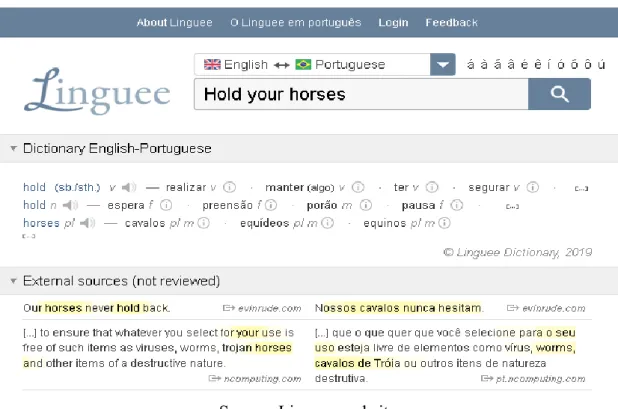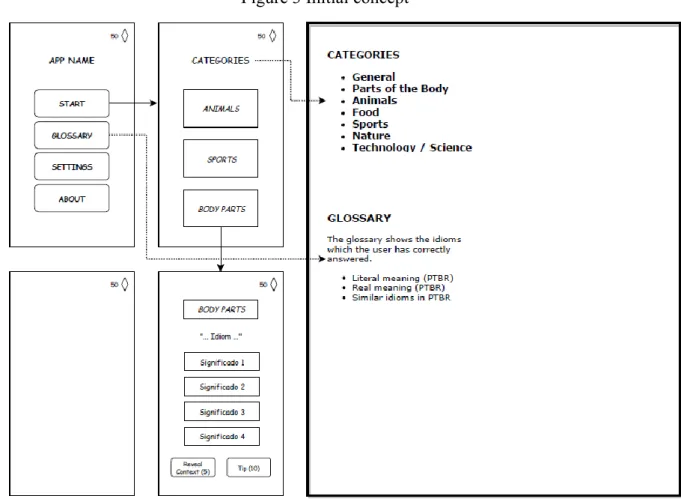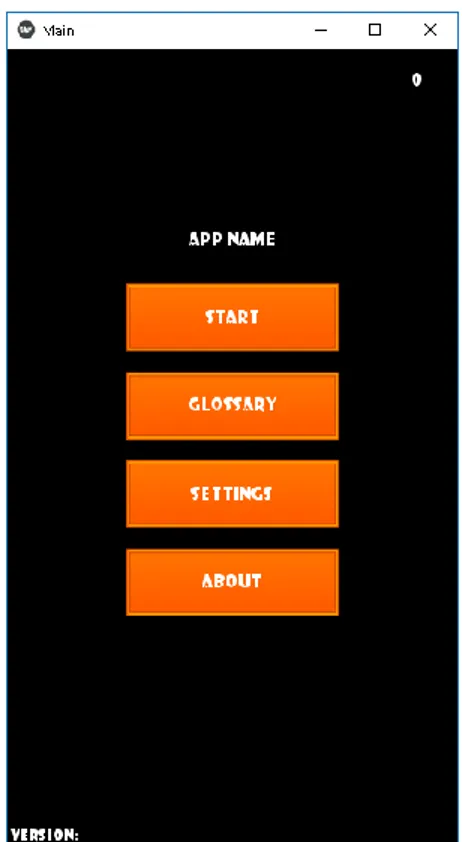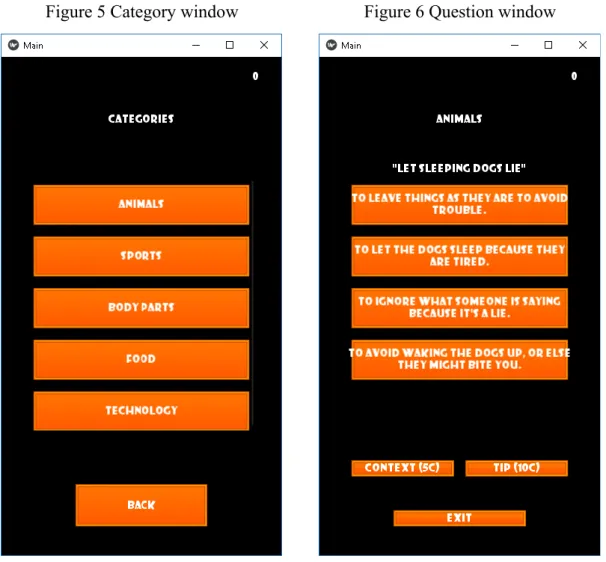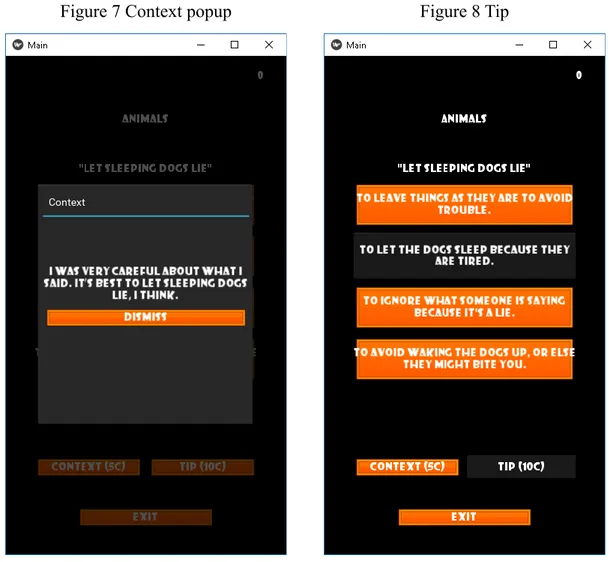A PROTOTYPE OF A CROSS-PLATFORM MOBILE APPLICATION FOR LEARNING IDIOMATIC EXPRESSIONS IN ENGLISH
Um protótipo de uma aplicação multiplataforma para o aprendizado de expressões idiomáticas em inglês
Guilherme Carrenho REZENDE (Fatec Ribeirão Preto, Ribeirão Preto/SP, Brasil) Anna Patrícia Zakem CHINA (Fatec Ribeirão Preto, Ribeirão Preto/SP, Brasil) Fabrício Gustavo HENRIQUE (Fatec Ribeirão Preto, Ribeirão Preto/SP, Brasil)
ABSTRACT: Idiomatic expressions, are considered an important topic in the English lexicon and becoming acquainted with them is fundamental for those who desire to enhance their fluency in this language. Nonetheless, due to the nature of these expressions, many students face difficulties when trying to learn them. Fortunately, with the advance of technology, new strategies have been implemented in the educational field and the teaching-learning process of foreign-languages have improved significantly. From this perspective, this article aims to present a prototype of a cross-platform mobile application for learning idiomatic expressions in English, emphasizing the importance of gamification as a relevant tool from a pedagogical viewpoint.
KEYWORDS: Idiomatic expressions; Gamification of learning; Mobile application; Technology; Prototype
RESUMO: Expressões idiomáticas são consideradas um tópico importante do léxico da língua inglesa e se familiarizar com elas é fundamental para aqueles que desejam aprimorar a fluência neste idioma. Todavia, devido à natureza dessas expressões, muitos alunos encontram dificuldades para aprendê-las. Felizmente, com o avanço da tecnologia, novas estratégias vêm sendo implementadas no campo educacional, e o processo de ensino-aprendizagem de línguas estrangeiras vêm melhorando significativamente. Nessa perspectiva, este artigo visa apresentar um protótipo de uma aplicação multiplataforma para dispositivos móveis para o aprendizado de expressões idiomáticas em inglês, enfatizando a importância da gamificação como uma ferramenta relevante no ponto de vista pedagógico.
PALAVRAS-CHAVE: Expressões idiomáticas; Gamificação do aprendizado; Aplicação móvel; Tecnologia; Protótipo
INTRODUCTION
With English being one of the most spoken languages on the planet, and also considered the main language for foreign affairs, many students seek to learn it in order to overcome the language barriers, and as a consequence, open a door to a new world of opportunities. Notwithstanding, if a student wants to improve one’s level of fluency in English, he or she will need to understand how to construe the cultural aspects of the language, which play a fundamental role in the way many words are connected to create a context.
In English, there are many ways to combine words to express an idea. Most of the time, these word combinations sound unnatural for non-native speakers, but are commonly used by native speakers in conversations. For instance, according to the Merriam-Webster Online Dictionary (2018), it’s possible to combine a verb with an adverb or preposition to make a phrasal verb, which represents a new verb and its meaning differs from the meaning of the isolated words used in a combination. Additionally, there are collocations, which are groups of two or more words that are generally used together. Lastly, another example of word combination are idiomatic expressions, or idioms, which can be “considered as fixed chunks with arbitrary meaning. For example, the ‘idiom kick the bucket’ cannot be interpreted by simply interpreting the meanings of each single word” (CHEN; LAI, 2013, p.13).
As stated above, being able to understand these aspects of the language is a must for those students who want to enhance their fluency in English. However, the major problem is that the process of learning these word combinations can be quite troublesome for non-native speakers. The fact that idiomatic expressions don’t carry the literal meaning of the words is an evident challenge by itself, and it becomes even harder when the student lacks the comprehension of the language’s cultural background.
Fortunately, with the fast advancement of technology, new strategies have been adopted to improve the students´ learning process across the globe. On-line dictionaries, automatic translators, virtual courses, educational applications and games are just a few examples. Furthermore, the use of mobile devices has become ubiquitous in society, mainly due to its convenient way of handling several activities of our daily lives.
With that in mind, this article intends to propose the development of a prototype of an educational application for mobile devices that could be very beneficial for Brazilian-Portuguese speakers who want to improve their fluency by practicing and studying the use of idiomatic expressions.
LEARNING IDIOMS AND ITS CHALLENGES
non-native speakers. However, in order to reach this objective, it’s essential that the students be prepared to become acquainted with the various idiomatic expressions used in English, for the simple fact that these expressions are used on a regular basis by native speakers.
In the English language, idiomatic expressions are spontaneously used by native speakers daily. It is an essential part of the English language lexicon and vocabulary. Idiomatic expressions are, therefore, considered inevitable for non-native speakers of English. As a result, Non-native speakers of English should get accustomed to using these expressions. Non-native speakers of English need to learn idiomatic expressions and practice how to use them, parallel to native speakers (THIAB, 2016, p.107).
According to O’Dell and McCarthy, idioms are a type of formulaic language, which are fixed expressions that you learn and understand as units rather than as individual words ( O’DELL; MCCARTHY, 2017, p.6). Learning idiomatic expressions in any language is no easy task, one can’t just simply learn an idiom by translating its individual words, mainly because of the fact that their literal meaning doesn’t necessarily represent what the expression is trying to say. Furthermore, as pointed by Chen and Lai (2013), the cultural aspect of each language makes the process even more complicated:
For EFL learners who lack exposure to the target language and culture, to acquire English idioms means to learn both language and cultural conventions. Therefore, the suggested teaching method gives considerations to both language and culture, and provides EFL learners with dependable clues in comprehending and learning idiomatic expressions. (CHEN; LAI, 2013, p.13)
Despite the difficulties in the process of learning idioms, there are a few methods that have been used to properly teach them, some are considered to be more traditional and others not so much. Yi-chen Chen and Huei-ling Lai (2013) present a few methods that have been used in material designed for EFL students and propose a new strategy using metaphoric mappings. The methods presented by Chen and Lai are the following: teaching idioms as formulaic expressions through memorization, where students will learn the idiom by relating it with a similar idiom in their native language; teaching idioms as metaphors through awareness-raising activities, by instigating the student to hypothesize about how the idiom might have originated; teaching idioms as metaphors through conceptual metaphors, where the student can use the knowledge of a specific concept in order to understand the idea of the idiom (source concept and target concept). Regardless of the method used to learn idiomatic expressions, the fact is that without the supervision of a teacher to guide the student, who may or may not have difficulties understanding the cultural aspects behind the idioms, the process of learning these expressions can become a burden. However, with the amount of information and
tools people have in their hands in our contemporary society, many are adopting self-learning practices and this may cause a deficiency in their self-learning process if they aren’t careful enough to choose their sources correctly.
For instance, if a learner tries to look up the meaning of a specific idiom on the internet using the most common tools available, he or she will find out that the process is not as easy as it should be, because some of these tools do not always bring the actual meaning of the expression but the literal meaning of the individual words. On the bright side, there are many tools, which can be quite helpful for students who want to learn idiomatic expressions in English, that not only show the actual meaning, but also presents a phrase in order to demonstrate the context in which the expression is immersed.
By comparing two of the most used online dictionaries, it’s possible to have an idea of how different their approach regarding idiomatic expressions can be. Figure 1 shows how Linguee handles the translation of the idiom “hold your horses” to Brazilian Portuguese. As can be seen in the figure 1, Linguee translates the words individually, and shows examples of these words in specific contexts. On the other hand, Cambridge Dictionary (figure 2) will understand that the content of the search is actually an idiom, and therefore will show its actual meaning, alongside a phrase to demonstrate how it is used in a context. This does not mean that Linguee is not a great tool, on the contrary, its approach is quite useful if a person wants to check how a word can be used in a set of contexts, additionally, it also brings the translations in the desirable language.
Figure 1 Linguee example
Figure 2 Cambridge example
Source: Cambridge dictionary website
Therefore, it’s important to reinforce the point that, when studying alone, it’s crucial to know what the available online tools can offer to aid the learning process of a foreign language.
GAMIFICATION OF LEARNING
It is undeniable the fact that the video game market has been dominating the entertainment industry for the past decade, overcoming, in terms of revenue, the music and movie industries combined.
[...]in 2012, global revenues were an estimated $67 billion for console and portable hardware and software, as well as games for mobile devices (e.g., tablets and smartphones). Sales of so-called virtual goods within games generated an additional $14.8 billion in 2012. These totals are about five times higher than global music revenues ($16.5 billion in 2011), higher than consumer book sales ($69.4 billion in 2011), and similar to movie revenues ($85 billion in 2011). Video games thus appear to be the fastest growing and most exciting category of mass media for the coming decade15. (MARCHAND; HENNIG-THURAU, 2013)
This is an important factor considering that the biggest consumers of the video game industry are the younger generations, raising many discussions regarding the effects of gaming in the sociocultural realm of this age group. The influence of video games on teenagers can shape their perspectives on various social subjects such as poverty, war, environment, crimes and democratic citizenship (KAHNE; MIDDAUGH; EVANS, 2009, p.62). Accordingly, it should be possible to take advantage of this influence in order to aid the teaching-learning process of several important subjects.
Some companies and universities have already started to understand how impactful games can be on helping students in their learning. A recent example is Ubisoft’s Game Creator’s Odyssey, which is a course designed by the game company Ubisoft aimed for university students who want to delve into game development. The course is actually a video game that intends to teach students about the game design industry based on a theoretical and practical approach. Many universities have already shown interest in this program, including Concordia University (Canada), where its interim President Graham Carr (2019) said: “at Concordia, we are always looking at ways to expand and improve learning”.
From a pedagogical point of view, the use of video games for teaching is very constructive. Several research studies have shown that games can bring educational benefits in the classroom or at home (GROFF; HOWELLS; CRANMER, 2012, p.35).
Like any successful pedagogy, outcomes need to be well planned and classrooms carefully organized to enable all students to engage in learning. What is notable about using games for learning is the potential they have for allowing many children to bring their existing interests, skills and knowledge into the classroom and then use games as a hook or stimulus to build the activities for learning around them. (GROFF; HOWELLS; CRANMER, 2012, p.51).
Just to name a few of the benefits of using games in the teaching-learning process: a) Intuitive way to immerse the learner.
b) Reward systems can enhance competitivity and desire to learn. c) Improve problem solving capabilities.
d) Increased portability, with the aid of mobile devices. e) It’s fun.
The success of platforms like Duolingo corroborate the usefulness and importance of gamification in learning. Duolingo is a mobile and web platform where people can learn foreign languages anywhere and at anytime Duolingo uses the resource of gamification to entertain its target audience while they efficiently learn another language, making it the language-learning platform with most users registered, by an estimated 300 million users (September, 2019) according to Duolingo.
Taking this into account, it is possible to use the Duolingo’s approach for improving one’s level of fluency in a specific language by teaching and learning idiomatic expressions, which is a necessity for foreign students who want to enhance their understanding of a language. This can be achieved by developing an educational and intuitive game for mobile devices with the aim of aiding the teaching-learning process associated with typical idioms, therefore promoting the improvement of language fluency in foreign students.
METHODOLOGY
The main objective of this paper is to propose the development of a prototype for a mobile application for Android and iOS to support the learning of idiomatic expressions in English for Portuguese-speaking students.
The first step that was taken was the initial data research, which was essential to acquire enough information to discuss the feasibility of the project and its implications. Then, a bibliographical research was done in order to build the foundation of the project. At this stage, based on all the previous gathering, the technologies which would be used to develop the prototype were chosen. After choosing the technologies, which consists in the programming languages, frameworks, tools, storage management and targeted devices, a study was done with the purpose of verifying if they were a viable choice to build the application. After confirming all the technologies and having enough data to support the creation of the application, it was time to start building the prototype.
The prototype was built in the form of a quiz game which presents several English idioms, pre-defined according to a specific theme. The user will be able to choose one of four alternative answers, which represents the supposed meaning of the idiom in Portuguese. If answered correctly, the user will earn points that could be used to exchange for tips in the next questions. The tips were designed in the following formats:
a) one of the wrong answers is removed from the available choices
b) a context is shown in order to facilitate the understanding of the idiom. Figure 3 shows the initial concept of the interfaces of the application.
Figure 3 Initial concept
Since the project was aimed to be used in mobile devices, specifically the ones using Android and iOS, the chosen tools to build the prototype should be cross platform friendly. At first, the intention was to use a game engine, such as Unity or Godot, however, due to the learning curve and the available time left, this option was discarded. Building it separately for Android, using Android Studio, and iOS, with Xcode, wasn’t a good option either for the same reasons. The solution was to use Kivy framework, which according to its site (kivy.org) is an open source Python library for rapid development of applications that make use of innovative user interfaces, such as multi-touch apps. Some benefits of using kivy are: first, it’s cross platform, so it’s possible to run the same code on Linux, Windows, Android and iOS; second, the interface can adapt depending on the device you are using; and finally, you write the code in python, which has an active and fast-growing community.
For data and storage management, SQLite was used, which can be easily handled. According to sqlite.org, SQLite is a library that implements a small, fast, self-contained, high-reliability, full-featured, SQL database engine, thus being perfect for the prototype.
Other tools were used in the process of creating the prototype: Visual Studio Code, a simple but powerful source code editor that is available for the three most used operating systems, Linux, macOS and Windows; Gimp 2.10.8, which is a cross-platform image
editor; and DB Browser for SQLite (DB4S) was used to aid the creation and design of the database for the prototype.
RESULTS
With the prototype project concluded, the results are presented as following: Figure 4 Home window
The Home Window (figure 4) presents the initial menu. The Start option leads the user to a new window where he can choose the category of the questions. The Glossary option is not implemented yet, once implemented the user will be able to check the idioms which have been answered correctly, showing its context, literal and real translation to Portuguese, and similar idioms in Portuguese used to express the same idea. The Settings options has not been implemented, but it will be used for modifying some preferences, such as sound, colors and accounts. The About option is currently used for showing some information about the application, such as objective and authors. Additionally, on the top-right corner the user can see how many points he has earned.
Figure 5 Category window Figure 6 Question window
The Category Window (figure 5) presents a list with several categories of idiomatic expressions which were chosen in a way to diversify and organize the quiz questions. After choosing a category, a series of questions will be presented to the user.
The Questions Window (figure 6) is where the questions are shown. specific idiom is presented to the according to the category chosen and four possible meanings for such expression. After choosing an answer, the user is taken to a new window where it shows if the chosen option was the correct one or not, furthermore, if answered correctly, the user is rewarded with points. The user can also opt for choosing to spend his points in showing a popup window with an example of the idiom (figure 7), moreover, the user can also remove one of the wrong options by choosing the tip button (figure 8).
Figure 7 Context popup Figure 8 Tip
The current results of the prototype serve as a basis for evaluating if a mobile application for learning idiomatic expressions in English can indeed be helpful.
FINAL CONSIDERATIONS
Idiomatic expressions are present in practically all languages and they are used instinctively by those who possess a high level of fluency. With that in mind, learning these expressions is a must for foreign students who want to perfect their fluency. Considering that learning idioms is not an easy task, there is a necessity to find better methods to teach and learn them.
Including digital technology in education, the arsenal of tools that can be used in the teaching-learning process have increased significantly. For instance, many researchers have already considered the use of gamification as an important educational resource.
Therefore, by having a simple and playful way to learn idiomatic expressions, it is possible that the learning efficiency of a student enhances by a considerable margin. Thus, an application for mobile devices is an excellent solution, because it allows an
intuitive and sophisticated way to involve the learner. Moreover, the portability of mobile devices has become a fundamental aspect in society, therefore anyone can use its features in nearly anyplace they want.
To that end, the prototype presented by this paper tries to demonstrate the first steps of what could be an effective and enjoyable way to learn idioms in English.
REFERENCES
CHEN, Y.C.; H.L. LAI. 2013. Teaching English idioms as metaphors through cognitive-oriented methods: A case in an EFL writing class. English Language Teaching, 6.6: 13-20.
"definition phrasal verb." Merriam-Webster Online. Available at: <https://www.merriam-webster.com>. Accessed: 24 Nov. 2018.
GROFF, J.; C. HOWELLS; S. CRANMER. 2012. Console game-based pedagogy: A study of primary and secondary classroom learning through console video games. International Journal of Game-Based Learning, 2.2: 35-54.
KAHNE, J.; E. MIDDAUGH; C. EVANS. 2009. The Civic Potential of Video Games. Cambridge, MA: MIT Press.
MAESTRACCI, V. 2019. Ubisoft and Concordia launch an innovative video game design course for university students around the world. Available at: <https://www.concordia.ca/news/stories/2019/09/24/ubisoft-and-concordia-launch-an-innovative-video-game-design-course-for-university-students.html>. Accessed: 07 Oct. 2019.
MARCHAND, A.; T. HENNIG-THURAU. 2013. Value Creation in the Video Game Industry: Industry Economics, Consumer Benefits, and Research Opportunities. Journal of Interactive Marketing, 27.3: p.141-157.
O'DELL, F.; M. MCCARTHY. 2017. English Idioms in Use Advanced with Answers. Cambridge: Cambridge University Press.
THYAB, R.A. 2016. The Necessity of idiomatic expressions to English Language learners. International Journal of English and Literature, 7.7: 106-111
